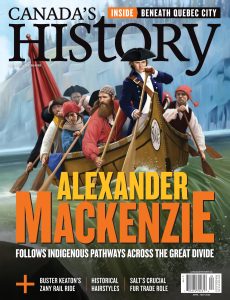
Canada’s History – April-May 2022
English | 70 pages | pdf | 14.55 MB
Welcome at Canada’s History Magazine April-May 2022 Issue
By the time I was old enough to watch TV, Star Trek, which ran for only three seasons between 1966 and 1969, had already been cancelled. But in the late 1970s I was finally able to watch reruns of what would become one of my favourite shows. To this day, I can still recite by memory James T. Kirk’s earnest pledge “to explore strange new worlds, to boldly go where no man has gone before.”
The swashbuckling starship captain, played by Canadian William Shatner, led every team and single-handedly saved the universe countless times. Or did he? In reality, Kirk didn’t go it alone — he was helped by his heroic crew, officers like Spock, Uhura, and Scottie the engineer. Even the nameless red-shirted security guards did their part by saving Kirk from alien threats.
In a way, Kirk is like many of the real-life explorers who dominated the pages of history textbooks for generations. Presented as solo acts, explorers
like Samuel de Champlain and John Rae actually relied heavily on the expertise and assistance of their support teams, as well as the Indigenous peoples they met while “discovering” new lands.
In Canada’s History Magazine April-May 2022 issue , we recall the story of Alexander Mackenzie, who, in the late-eighteenth century, became the first European to cross the continent north of Mexico. In “Exploration and Empire,” historian Barry Gough follows Mackenzie’s gruelling journey from Fort Chipewyan, in northern Alberta, across the treacherous mountain passes and river gorges of the continental divide, to the Pacific Ocean at the mouth of the Bella Coola River in British Columbia.
As Gough shows, Mackenzie relied heavily on his team of voyageur paddlers and First Nations hunters, interpreters, and guides. Crucially, he also listened to the Indigenous peoples whom he met along the way. In some cases, their advice likely saved the lives of Mackenzie and his crew.
Elsewhere in this magazine issue, we explore the surprising story of salt deposits onthe prairies, get tangled up in the history of hairstyles, and even ride the rails across Canada with one of silent film’s greatest showmen.
As for Mackenzie, at one point in his trip, he was warned against descending the Fraser River, then known as Tatouche Tesse. “The Indigenous people warned that going downriver on the wild and furious Tatouche Tesse would lead to certain death,” Gough writes. Mackenzie wisely backtracked and took a safer route. In this way, he certainly was no Captain Kirk. The Enterprise’s captain would have stubbornly stayed the course, while losing half of his away team. Mackenzie’s men all made it home safe and sound. That, surely, is the best way to explore “strange new worlds.”
Download from: